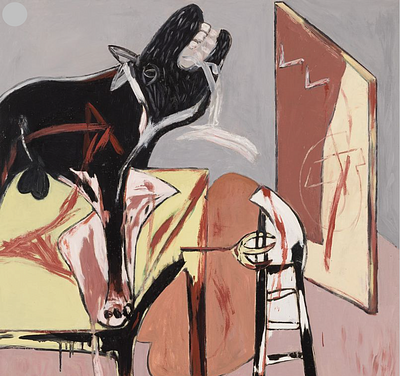"LAXEIRO"; JOSÉ OTERO ABELEDO (Lalín, Pontevedra, 1908 - Vigo, 1996). "Maternity", 1948. Charcoal on paper.
Lot 57
About Seller
Setdart Auction House
Carrer Aragó 346
Barcelona
Spain
Setdart Subastas was born in 2004 and is currently the first online art auction in Spain with solidity, prestige and reliability guaranteed by our more than 60,000 users. Setdart has a young, dynamic and enterprising team ready to successfully manage the purchase and sale of art works through custom...Read more
Categories
Estimate:
EUR€4,500 - EUR€5,000
$4,838.71 - $5,376.34
Absentee vs Live bid
Two ways to bid:
- Leave a max absentee bid and the platform will bid on your behalf up to your maximum bid during the live auction.
- Bid live during the auction and your bids will be submitted real-time to the auctioneer.
Bid Increments
| Price | Bid Increment |
|---|---|
| EUR€0 | EUR€10 |
| EUR€200 | EUR€25 |
| EUR€500 | EUR€50 |
| EUR€1,000 | EUR€100 |
| EUR€3,000 | EUR€200 |
| EUR€5,000 | EUR€500 |
| EUR€10,000 | EUR€1,000 |
| EUR€20,000 | EUR€2,000 |
| EUR€50,000 | EUR€5,000 |
About Auction
By Setdart Auction House
Nov 16, 2021
Set Reminder
2021-11-16 08:00:00
2021-11-16 08:00:00
America/New_York
Bidsquare
Bidsquare : Contemporary and Actual Art
https://www.bidsquare.com/auctions/setdart-auction-house/contemporary-and-actual-art-7839
Setdart Auction House sofia@setdart.com
Setdart Auction House sofia@setdart.com
- Lot Description
"LAXEIRO"; JOSÉ OTERO ABELEDO (Lalín, Pontevedra, 1908 - Vigo, 1996). "Maternity", 1948. Charcoal on paper. Signed, dated and located (Vigo), in the upper right area. Measurements: 132 x 125 cm; 137,5 x 131 cm (frame). The maternity was a recurrent theme in Laxeiro's work, which started in a certain way from a religiosity based on the figure of the Virgin with the Child, replacing the figure of the mother, by a woman of round volumes, representation of the Galician woman. This work in particular is part of the cataloging of the archives of the Laxeiro Foundation, which in 2005 organized an exhibition with several drawings by the artist, thus demonstrating its intention to address the broad task of cataloging all his drawings. Laxeiro began his training as a child in Botos (Pontevedra), where he had Teresa López as his first teacher. Shortly afterwards, in 1921, he emigrated to Cuba with his family. There he worked in crafts through which he approached the world of art, from engraving to glassmaking. He attended drawing classes and worked as an assistant to the Catalan Manuel Roig, choreographer of the Martí Theater. In 1925 he visited the exhibitions held in Cuba of Zuloaga and Jesús Corredoyra, and worked designing artistic stained glass. However, due to a serious illness he had to return to Spain, settling in Lalín. At this time he left professional painting aside, and established himself as an itinerant barber in 1926, often portraying his clients and various popular types. Two years later he began to make himself known, publishing vignettes in the "Faro de Vigo". The following year he also published his illustrations in "El Pueblo Gallego". In 1930 he receives painting classes from the Argentinean painter Enrique Larrañaga, in Vigo, and the following year he receives a scholarship from the City Council of Lalín to continue his artistic studies in Madrid. He enters then as a free student in the Academy of Fine Arts of San Fernando, and at the same time he frequents the gathering of the Granja del Henar. He returned to Galicia in 1933 and began to hold exhibitions, making his individual debut in 1934 at the Faculty of Philosophy and Letters in Santiago de Compostela. After the war he settled in Pontevedra, where in 1940 he began his teaching career at the Valle-Inclán Institute. In the following years he obtained pensions from the Provincial Council, and resumed his exhibition career in Galicia, Madrid and Bilbao. In 1951 he was invited to hold an exhibition in Buenos Aires, the city where he finally decided to settle. In the seventies he returned definitively to Spain, living between Pontevedra and Madrid, exhibiting all over Spain, already as a fully recognized author. His awards include the Medal of the Biennial of Pontevedra, the Castelao Medal of the Junta de Galicia and the Gold Medal of the City Council of Vigo. He has his own museum in that city, as well as a monographic room in the Castrelos Museum and a wide representation in all Galician museums, as well as in numerous private collections in Spain and America.
- Shipping Info
-
In-house shipping available. Please inquire at admin@setdart.com.
-
- Buyer's Premium



 EUR
EUR CAD
CAD AUD
AUD GBP
GBP MXN
MXN HKD
HKD CNY
CNY MYR
MYR SEK
SEK SGD
SGD CHF
CHF THB
THB
















